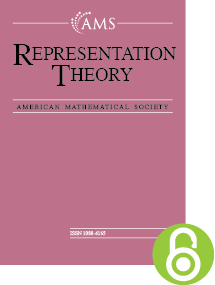A Katsylo theorem for sheets of spherical conjugacy classes
HTML articles powered by AMS MathViewer
- by Giovanna Carnovale and Francesco Esposito
- Represent. Theory 19 (2015), 263-280
- DOI: https://doi.org/10.1090/ert/470
- Published electronically: November 2, 2015
- PDF | Request permission
Abstract:
We show that, for a sheet or a Lusztig stratum $S$ containing spherical conjugacy classes in a connected reductive algebraic group $G$ over an algebraically closed field in good characteristic, the orbit space $S/G$ is isomorphic to the quotient of an affine subvariety of $G$ modulo the action of a finite abelian $2$-group. The affine subvariety is a closed subset of a Bruhat double coset and the abelian group is a finite subgroup of a maximal torus of $G$. We show that sheets of spherical conjugacy classes in a simple group are always smooth and we list which strata containing spherical classes are smooth.References
- Michaël Bulois, Sheets of symmetric Lie algebras and Slodowy slices, J. Lie Theory 21 (2011), no. 1, 1–54. MR 2797818
- Nicolas Bourbaki, Éléments de mathématique, Masson, Paris, 1981 (French). Groupes et algèbres de Lie. Chapitres 4, 5 et 6. [Lie groups and Lie algebras. Chapters 4, 5 and 6]. MR 647314
- N. Cantarini, G. Carnovale, and M. Costantini, Spherical orbits and representations of ${\scr U}_\epsilon ({\mathfrak {g}})$, Transform. Groups 10 (2005), no. 1, 29–62. MR 2127340, DOI 10.1007/s00031-005-1002-z
- Giovanna Carnovale, Spherical conjugacy classes and involutions in the Weyl group, Math. Z. 260 (2008), no. 1, 1–23. MR 2413339, DOI 10.1007/s00209-007-0244-y
- Giovanna Carnovale, A classification of spherical conjugacy classes in good characteristic, Pacific J. Math. 245 (2010), no. 1, 25–45. MR 2602680, DOI 10.2140/pjm.2010.245.25
- Giovanna Carnovale, Lusztig’s partition and sheets (with an appendix by M. Bulois), Math. Res. Lett. 22 (2015), no. 3, 645–664. MR 3350097, DOI 10.4310/MRL.2015.v22.n3.a1
- G. Carnovale and M. Costantini, On Lusztig’s map for spherical unipotent conjugacy classes, Bull. Lond. Math. Soc. 45 (2013), no. 6, 1163–1170. MR 3138484, DOI 10.1112/blms/bdt048
- Giovanna Carnovale and Francesco Esposito, On sheets of conjugacy classes in good characteristic, Int. Math. Res. Not. IMRN 4 (2012), 810–828. MR 2889158, DOI 10.1093/imrn/rnr047
- Kei Yuen Chan, Jiang-Hua Lu, and Simon Kai-Ming To, On intersections of conjugacy classes and Bruhat cells, Transform. Groups 15 (2010), no. 2, 243–260. MR 2657442, DOI 10.1007/s00031-010-9084-7
- Mauro Costantini, A classification of unipotent spherical conjugacy classes in bad characteristic, Trans. Amer. Math. Soc. 364 (2012), no. 4, 1997–2019. MR 2869197, DOI 10.1090/S0002-9947-2011-05390-0
- M. Costantini, A classification of spherical conjugacy classes, arXiv:1503.03827.
- Morikuni Goto and Frank D. Grosshans, Semisimple Lie algebras, Lecture Notes in Pure and Applied Mathematics, Vol. 38, Marcel Dekker, Inc., New York-Basel, 1978. MR 0573070
- A. Grothendieck, Séminaire de Géométrie Algébrique du Bois Marie - 1960-61 - Rev$\hat {e}$tements étales et groupe fondamental - (SGA 1) , Lecture Notes in Mathematics 224, Berlin; New York: Springer-Verlag (1971).
- Robin Hartshorne, Algebraic geometry, Graduate Texts in Mathematics, No. 52, Springer-Verlag, New York-Heidelberg, 1977. MR 0463157, DOI 10.1007/978-1-4757-3849-0
- Xuhua He and George Lusztig, A generalization of Steinberg’s cross section, J. Amer. Math. Soc. 25 (2012), no. 3, 739–757. MR 2904572, DOI 10.1090/S0894-0347-2012-00728-0
- A. E. Im Hof, The sheets in a classical Lie algebra, Ph.D. thesis, Basel, http:// edoc.unibas.ch/257/ (2005).
- P. I. Katsylo, Sections of sheets in a reductive algebraic Lie algebra, Izv. Akad. Nauk SSSR Ser. Mat. 46 (1982), no. 3, 477–486, 670 (Russian). MR 661143
- Ivan Losev, 1-dimensional representations and parabolic induction for W-algebras, Adv. Math. 226 (2011), no. 6, 4841–4883. MR 2775887, DOI 10.1016/j.aim.2010.12.021
- Jiang-Hua Lu, On a dimension formula for spherical twisted conjugacy classes in semisimple algebraic groups, Math. Z. 269 (2011), no. 3-4, 1181–1188. MR 2860282, DOI 10.1007/s00209-010-0776-4
- G. Lusztig, On conjugacy classes in a reductive group, arxiv:1305.7168, to appear in the Proceedings of Vogan60 Conference.
- G. Lusztig and N. Spaltenstein, Induced unipotent classes, J. London Math. Soc. (2) 19 (1979), no. 1, 41–52. MR 527733, DOI 10.1112/jlms/s2-19.1.41
- David Mumford, Geometric invariant theory, Ergebnisse der Mathematik und ihrer Grenzgebiete, (N.F.), Band 34, Springer-Verlag, Berlin-New York, 1965. MR 0214602, DOI 10.1007/978-3-662-00095-3
- Alexander Premet, Commutative quotients of finite $W$-algebras, Adv. Math. 225 (2010), no. 1, 269–306. MR 2669353, DOI 10.1016/j.aim.2010.02.020
- Alexander Premet and Lewis Topley, Derived subalgebras of centralisers and finite $W$-algebras, Compos. Math. 150 (2014), no. 9, 1485–1548. MR 3260140, DOI 10.1112/S0010437X13007823
- Alexey Sevostyanov, Algebraic group analogues of the Slodowy slices and deformations of Poisson $W$-algebras, Int. Math. Res. Not. IMRN 8 (2011), 1880–1925. MR 2806525, DOI 10.1093/imrn/rnq139
- A. Sevostyanov, A proof of De Concini-Kac-Procesi conjecture II. Strictly transversal slices to conjugacy classes in algebraic groups, arXiv:1403.4108.
Bibliographic Information
- Giovanna Carnovale
- Affiliation: Dipartimento di Matematica, Torre Archimede - via Trieste 63 - 35121 Padova, Italy
- MR Author ID: 638877
- Email: carnoval@math.unipd.it
- Francesco Esposito
- Affiliation: Dipartimento di Matematica, Torre Archimede - via Trieste 63 - 35121 Padova, Italy
- MR Author ID: 841112
- Email: esposito@math.unipd.it
- Received by editor(s): January 19, 2015
- Received by editor(s) in revised form: September 5, 2015, and September 10, 2015
- Published electronically: November 2, 2015
- Additional Notes: The present work was partially supported by Progetto di Ateneo CPDA125818/12 of the University of Padova, FIRB 2012 Prospettive in Teoria di Lie and PRIN 2012 Spazi di Moduli e Teoria di Lie.
- © Copyright 2015 American Mathematical Society
- Journal: Represent. Theory 19 (2015), 263-280
- MSC (2010): Primary 20G15; Secondary 17B45
- DOI: https://doi.org/10.1090/ert/470
- MathSciNet review: 3417486


